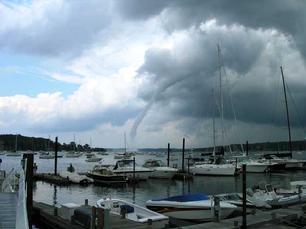|
Vincent Pica
Chief of Staff, First District, Southern Region (D1SR)
United States Coast Guard Auxiliary
|
|
Preparing (Again) for Hurricanes
Back on April 30, 2008, we wrote about the preparedness exercise call “Hurricane Elizabeth.” Under the direction of District (1SR) USCGAux Commodore Thomas Venezio and USCG Commander E. D. Young, Director of the Auxiliary (1SR), USCG Forces conducted an exercise – a Cat-4 Hurricane called Elizabeth. As noted many times, we often speak about the “next 9/11” as being inevitable. We have to be perfect everyday. “They” have to be lucky just once. With a constant eye for that, it is still more likely that it will be a natural disaster that will affect more of us and potentially in a deadly fashion. Back on November 7, 2007, we wrote here that even more likely than “another ’38 hurricane”, it is far more likely and far more common for us to get one like Noel in ’07… and Beryl in ’06… Cindy in ’05… Ivan in ’04…
|
 |
| click to enlarge - courtesy of USCGAux |
|
| Not to mention this brace of what I call “hurry-canes” we’ve gotten this summer – hurricanes or twisters that hurry in for 20-30 minutes, make a complete mess of everything and then disappear without so much as a tip of the hat…
But the exercise in April was what we call a “Table-Top” exercise. We plan for it; we talk about it; we find “kinks” in the system. But no one leaves the station, his or her house or place of business.
|
So, naturally, the next evolution is to simulate with actual activities. Starting on Tuesday, August 5, 2008, the simulated emergency message went out on the USCGAux emergency notification. Hurricane Liam was coming. He was due to arrive on Friday, August 8, 2008. This is about that week.
This Is a Drill, This Is a Drill, This Is a Drill
With those words at 5:30pm, August 5, USCG Auxiliarists all over the northeast received the simulated emergency message that Liam was bearing down on New York and Long Island on its way to New England. Auxilarists in this area, per the emergency plan, made way by vessel to (simulate) start spreading the word to private boaters that the trip out to the Canyons would turn deadly in just a couple of days. Other Auxiliarists made way in cars and trucks, radio-equipped in the marine and Auxiliary private bands, to also simulate getting the word out to marinas, dock masters, bait shops, marine chandleries – wherever private skippers gathered – that Liam was coming. Time to get the boats to their hurricane holes – and pronto. This went on until Friday, when everyone was instructed to stand down and ride out the hurricane with their loved ones. Then Saturday and Sunday were simulated clean-up and assessment days.
The Scoreboard
What happened? District 1(SR) conducted over 110 surface patrols (boats on our bays, creeks, rivers and oceans), 103 radio patrols (cars and trucks test driving routes to marinas etc in the northeastern US), 110 vessel examiners conducted over 300 vessel safety checks (hey, when you get lemons, make lemonade!), 50 program visitors conducted 335 program visits or MDA visits. In all, over 700 members of USCG Auxiliary forces participated in this event.
But What Should You Do???
In the real world, I doubt everything will go as smoothly as it did during in our drill. Nothing ever does. As I remind my children, life is what happens to you while you’re planning… But plan and train we must. So, what should you be doing..?
Well, we have two things to care for, beyond our loved ones – the house and the boat. Most likely, we’ll have two days to prepare. When you do that? Now.
Of course, start with a checklist and duct tape or the equivalent. When things starts to get bad, you’ll forget something. Plus, things are going to start flying and they need to be secured. Plastic tarping for windows, or better yet, plywood for nailing into the outer window jams has got to be part of proper pre-hurricane prep kit. Rags/towels for the inevitable sopping up actions and large garbage bags for getting items in bulk from one place (the boat) to another (attic, trunk of the car.) If you are forced to keep the boat in the water, be sure the cleats are still properly back-plated and that you have double- or triple-ups on your mooring lines – with chafe guards. Honestly, the chance of a boat surviving a hurricane on its mooring or in its slip is pretty close to nil. Find a way to get the boat at least up on blocks in the lee of something big..
After the hurricane, take pictures or videos of everything. If the boat has been sunk, get to your insurance company right away. Remember, salvage is very different than assistance under maritime law.
|
BTW, if you are interested in being part of USCG Forces, email me at JoinUSCGAux@aol.com or go direct to the D1SR Human Resources department, who are in charge of new members matters, at DSO-HR and we will help you “get in this thing…”
|
| <-- click there to tweet, post or otherwise distribute to the 'net
|
|